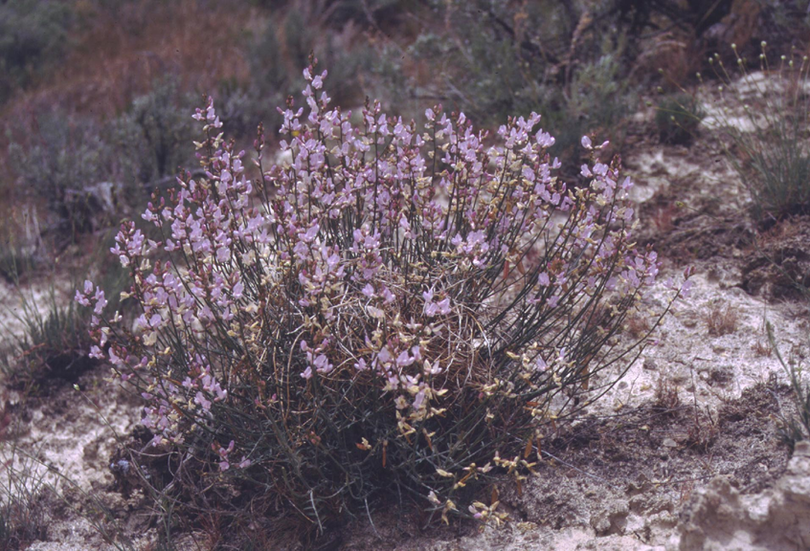BLM announces travel restrictions to protect rare plant in Payette County

The only place in the world where the rare Packard’s milkvetch plant is found is in a 10-square-mile area in Payette County in the Big Willow area, the BLM says, so it’s proposing new off-road travel restrictions in the area to protect the plant. The restrictions will include three designations: Areas open for motorized travel both on- and off-trail; areas closed to all motor vehicle use; and areas where motorized vehicles are limited to designated trails.
A 127-acre area would be designated as open, to allow “hill-climbing” and other off-roading. A 5,620-acre area would be closed; and 1,620 areas would be limited; the restrictions are scheduled to start in the fall.
“This decision is necessary because the habitat for Packard’s milkvetch is at risk from damage by motorized vehicle traffic,” said Terry Humphrey, field manager for the BLM Four Rivers Field Office. “These travel designations would allow motorized vehicle use to continue on designated trails and provide for hill climbing opportunities in certain areas, while insuring the protection of the plant and its habitat for further damage.
The Packard’s milkvetch is currently listed as a candidate species for protection from extinction under the Endangered Species Act; click below for the BLM’s full announcement. The agency developed the designations after two years of study, public meetings and outreach to area recreationists.
Travel designations will protect rare plant
on public lands in Payette County
BOISE, ID – In order to protect a rare plant, the Bureau of Land Management (BLM) is proposing off-highway vehicle (OHV) area travel designations for public lands next to Big Willow Creek located about 15 miles east of Payette. The travel designations will protect habitat for a plant, Packard’s milkvetch (Astragalus cusickii var. packardiae). The only place in the world where this rare plant is found is in a 10 square mile area in Payette County. The U.S. Fish and Wildlife Service (USFWS) recently designated the plant a Candidate Species for protection from extinction under the Endangered Species Act (ESA).
The BLM is proposing to amend the Cascade Resource Management Plan OHV designations affecting about 7,400 acres in the Big Willow area. The proposed travel designations identify areas that are “open” for motorized cross country travel, areas “closed” to motor vehicle use and areas where motorized vehicles are “limited” to designated trails.
The proposed area designation would change a 127-acre area to “open”. In this area, motorized use would be allowed both on and off of trails. The designation would close 5,620 acres to motorized use. In these areas, motorized vehicle use would not be allowed. Approximately 1,620 acres would remain designated as “limited”. In areas designated as limited, motorized vehicle use would be allowed only on designated trails. The area designations are scheduled to take effect by the fall of 2013.
Approximately 9 miles of trails would be designated for motorized use. Undesignated trails would be closed to motorized use. The BLM will fence the open area to delineate the boundary and mark designated trails.
A parking/staging area will be developed adjacent to Big Willow Road with information signs showing the OHV area designations. Signs will also be used to identify trails remaining open and those that are closed. Closed trails will be physically blocked by placing rock boulders across the routes and by other means.
Vegetation treatments and exclosure areas will help restore and protect Packard’s milkvetch plants and area habitat.
“This decision is necessary because the habitat for Packard’s milkvetch is at risk from damage by motorized vehicle traffic,” said Terry Humphrey, field manager of the BLM Four Rivers Field Office, where the travel designations are proposed. “These travel designations would allow motorized vehicle use to continue on designated trails and provide for hill climbing opportunities in certain areas while insuring the protection of the plant and its habitat from further damage.” Lands affected by the motorized vehicle designations would remain open to other uses, including non-motorized travel.
Two additional no-fee OHV recreation areas provide opportunities for unlimited cross-country use. Clay Peak Motorcycle Park is located 9 miles west of the Big Willow area near Payette and Little Gem Cycle Park is located near Emmett about 30 miles southeast of Big Willow.
Maps of these proposed travel designation areas and other related documents are posted on the BLM’s website at (www.id.blm.gov). Paper copies of the proposed travel designation maps can also be obtained by visiting the BLM Boise District Office at 3948 South Development Avenue, Boise, Idaho 83705. Please call Larry Ridenhour, outdoor recreation planner for the BLM Four Rivers Field Office, if you have questions regarding where to ride OHVs. Ridenhour’s phone number in Boise is 208-384-3334.
The BLM will enforce the travel designations under the authority of Section 303 of the Federal Land Policy and Management Act and pursuant regulations (43 CFR 8342). Federal, State and local employees performing official duties and those with written permission from the BLM are exempt from motorized travel in closed areas.
-BLM-
The BLM manages more than 245 million acres of public land, the most of any Federal agency. This land, known as the National System of Public Lands, is primarily located in 12 Western states, including Alaska. The BLM also administers 700 million acres of sub-surface mineral estate throughout the nation. The BLM's multiple-use mission is to sustain the health, diversity, and productivity of the public lands for the use and enjoyment of present and future generations. In Fiscal Year 2012, activities on public lands generated $4.6 billion in revenue, much of which was shared with the States where the activities occurred. In addition, public lands contributed more than $112 billion to the U.S. economy and helped support more than 500,000 jobs.
